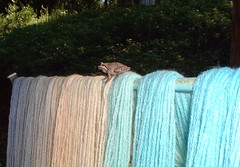Thursday, May 25, 2006
Monday, May 22, 2006
Inkle Weaving 101
As promised, an inkle loom tutorial.
First: what to make? I decided to make a bag for my cell phone, killing two birds, etc., by also giving Naomi an example of *what one could do with inkle bands*.
So here are the specs, the cell phone needs a bag about 3" by 5". I want it to hang outside my tote bag, so it needs a clip, and a small handle. This leftover silk cardweaving might do for a handle (said handle needs to be short, so the bag won't fly around and bang itself at every turn):

I'm using crochet cotton for this band, just to make sure the materials are generally accessible to anyone. Here are the colors I will use:
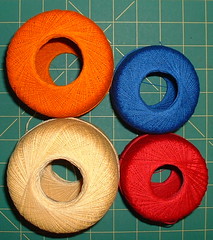
So I make a quick sketch to see if the colors, and color order are OK for the bag I have planned:

Now, we need a loom:
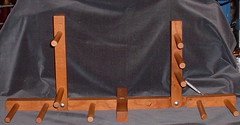
My old, handmade one. The Schacht is currently tied up, so I'll use this one, which my Dad made for me. It is not as sturdy or as accommodating for pickup patterning, but I will be making a plain band. (I also have a sentimental attachment to the loom: my Dad died 15 years ago. He was very supportive and made lots of equipment for me, so even if it is not the *most used* loom, it is the *most loved*).
The loom needs heddles, usually string, made according to the instructions that come with your loom. On the Schacht, the heddles are made using three of the pegs on the loom, handy, and the right size. However, I made these:
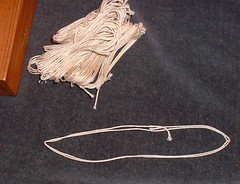
years ago, and they are the wrong size, oops! so I double them over, and then they are the right size. You will do better, and make yours correctly to begin with. These are made from crochet cotton too.
Then we begin warping:
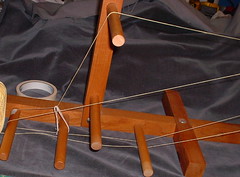
The first thread (yellow) is taped (with masking tape) to the front of the loom. This thread goes over the top peg, and gets a heddle to bring into alignment, then it is carried along the path chosen (short or long band?), and comes back to the start. The second thread by-passes the top peg, and goes to the back peg and around:
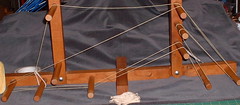
Only the threads that go over the top peg get heddles, the remainder are simply wound around and left un-heddled, free, so to speak. Once the number of yellow threads is done, the end is cut and taped. Then the second color is added, and the whole process repeats:
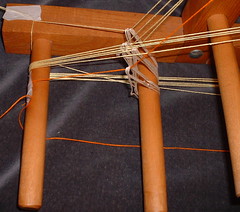
Until all the colors are done. The taped ends are all pulled together and tied into one knot:
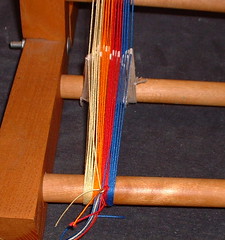
You can tell the design and the width of the finished band by the threads that go over the back peg (the front peg, you remember, has only half of them, the back peg has the full number of threads):
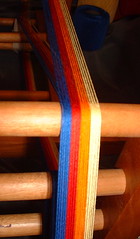
The loom is clamped to the table to make it more stable:
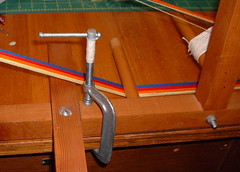
I use an old drafting table as a work space: it is counter height, so I stand to weave, or sit on a high stool. One of my band weaving teachers, Jaquetta Nisbet, was able to sit on the floor and stabilize her loom with her feet: I am not so agile! The clamp-to-the table works fine for me.
Now we need a weft, I'm using the blue crochet cotton:

The shuttle is from Interweave's Teach a Friend to Weave Contest (1980), which I entered with a friend, and oh the irony: now we are using the internet to teach several (?) imaginary internet friends to weave:
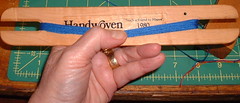
Jargon Alert: weaving involves passing the weft yarn between layers of warp. The heddles assist in creating the space for the weft to pass through. The space created between the layers of warp is called a shed. The heddles on this loom create two sheds, for plain weave , the classic over-and-under fabric.
The first shed is created by lifting the warps that are not held by heddles:
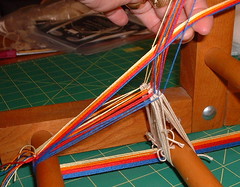
The second shed is created by pushing down those same warps:

The other warps remain stationary during the weaving process.
The first weft is passed through the shed created by lifting the warps:
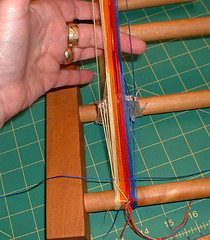
The second weft is passed, and on and on:
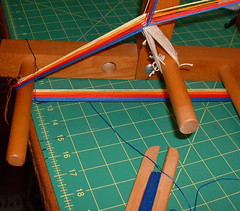
The end of the weft is tucked into the first few sheds, so that it is captured, and the whole thing doesn't fall apart when I take it off the loom. [Sorry, bad photo, hope you get the concept. By the time I got this out of the camera, and realized its *not usefulness*, it was too late: the weaving had moved on. But(!) what this photo does show, to those who are carefully following along, is that I moved the peg with the heddles. Oops! #2. I forgot which peg they went on. If this were a Real Tutorial (tm), the author would have gone back and started over, with new pictures, to show you the right way to set this up. But this is a Reality Tutorial (tm), wherein the weaver needs to fix a few things as she works. Thank you, now back to your regularly scheduled tutorial].
Weaving continues, advancing the warp as needed. When the weaving gets too close to the heddles, it is hard to open the shed. Periodically, the warps are pulled around to create a more space for the shed. To advance the warp, tension is released, and the threads are pulled around. Eventually, all the warp is woven:
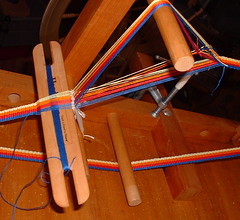
This took about an hour for me, on a Sunday morning, listening to Bhagavan Das chanting. Meditative music and activity combined: my version of devotion, so to speak.
The last few shots were tight:
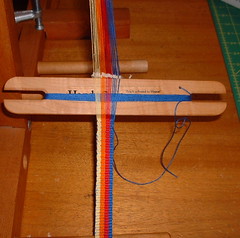
but I like to get all the warp woven off.
Here is the band just off the loom: about 72" long, with about 10" of loom waste:
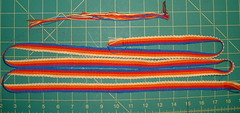
The last step is to wash the band, and press it, sort of like blocking in the knitting world:

68" of length in the finished band.
Next post: Making the Bag. I can't promise it will be tomorrow, but soon!
First: what to make? I decided to make a bag for my cell phone, killing two birds, etc., by also giving Naomi an example of *what one could do with inkle bands*.
So here are the specs, the cell phone needs a bag about 3" by 5". I want it to hang outside my tote bag, so it needs a clip, and a small handle. This leftover silk cardweaving might do for a handle (said handle needs to be short, so the bag won't fly around and bang itself at every turn):

I'm using crochet cotton for this band, just to make sure the materials are generally accessible to anyone. Here are the colors I will use:

So I make a quick sketch to see if the colors, and color order are OK for the bag I have planned:

Now, we need a loom:

My old, handmade one. The Schacht is currently tied up, so I'll use this one, which my Dad made for me. It is not as sturdy or as accommodating for pickup patterning, but I will be making a plain band. (I also have a sentimental attachment to the loom: my Dad died 15 years ago. He was very supportive and made lots of equipment for me, so even if it is not the *most used* loom, it is the *most loved*).
The loom needs heddles, usually string, made according to the instructions that come with your loom. On the Schacht, the heddles are made using three of the pegs on the loom, handy, and the right size. However, I made these:

years ago, and they are the wrong size, oops! so I double them over, and then they are the right size. You will do better, and make yours correctly to begin with. These are made from crochet cotton too.
Then we begin warping:

The first thread (yellow) is taped (with masking tape) to the front of the loom. This thread goes over the top peg, and gets a heddle to bring into alignment, then it is carried along the path chosen (short or long band?), and comes back to the start. The second thread by-passes the top peg, and goes to the back peg and around:

Only the threads that go over the top peg get heddles, the remainder are simply wound around and left un-heddled, free, so to speak. Once the number of yellow threads is done, the end is cut and taped. Then the second color is added, and the whole process repeats:

Until all the colors are done. The taped ends are all pulled together and tied into one knot:

You can tell the design and the width of the finished band by the threads that go over the back peg (the front peg, you remember, has only half of them, the back peg has the full number of threads):

The loom is clamped to the table to make it more stable:

I use an old drafting table as a work space: it is counter height, so I stand to weave, or sit on a high stool. One of my band weaving teachers, Jaquetta Nisbet, was able to sit on the floor and stabilize her loom with her feet: I am not so agile! The clamp-to-the table works fine for me.
Now we need a weft, I'm using the blue crochet cotton:

The shuttle is from Interweave's Teach a Friend to Weave Contest (1980), which I entered with a friend, and oh the irony: now we are using the internet to teach several (?) imaginary internet friends to weave:

Jargon Alert: weaving involves passing the weft yarn between layers of warp. The heddles assist in creating the space for the weft to pass through. The space created between the layers of warp is called a shed. The heddles on this loom create two sheds, for plain weave , the classic over-and-under fabric.
The first shed is created by lifting the warps that are not held by heddles:

The second shed is created by pushing down those same warps:

The other warps remain stationary during the weaving process.
The first weft is passed through the shed created by lifting the warps:

The second weft is passed, and on and on:

The end of the weft is tucked into the first few sheds, so that it is captured, and the whole thing doesn't fall apart when I take it off the loom. [Sorry, bad photo, hope you get the concept. By the time I got this out of the camera, and realized its *not usefulness*, it was too late: the weaving had moved on. But(!) what this photo does show, to those who are carefully following along, is that I moved the peg with the heddles. Oops! #2. I forgot which peg they went on. If this were a Real Tutorial (tm), the author would have gone back and started over, with new pictures, to show you the right way to set this up. But this is a Reality Tutorial (tm), wherein the weaver needs to fix a few things as she works. Thank you, now back to your regularly scheduled tutorial].
Weaving continues, advancing the warp as needed. When the weaving gets too close to the heddles, it is hard to open the shed. Periodically, the warps are pulled around to create a more space for the shed. To advance the warp, tension is released, and the threads are pulled around. Eventually, all the warp is woven:

This took about an hour for me, on a Sunday morning, listening to Bhagavan Das chanting. Meditative music and activity combined: my version of devotion, so to speak.
The last few shots were tight:

but I like to get all the warp woven off.
Here is the band just off the loom: about 72" long, with about 10" of loom waste:

The last step is to wash the band, and press it, sort of like blocking in the knitting world:

68" of length in the finished band.
Next post: Making the Bag. I can't promise it will be tomorrow, but soon!
Tuesday, May 16, 2006
The Learning Curve
Ellen's comment:
Regarding conferences, I think a lot of people (ok, maybe just me) think that you have to be an experienced weaver or spinner to participate. Convergence was in my hometown when I was just beginning to weave, and I didn't go because I didn't realize they had stuff for beginners.
got me to thinking this morning.
Oh, would that all conferences had beginning classes. Do knitting conferences? Do fiber festivals, like MD$&W? Weaving conferences sometimes do, sometimes don't. What a missed opportunity when they don't.
SOAR (the annual spinning conference hosted by Interweave) has in the last 5 years or so, been committed to having a beginning spinning class, taught by Maggie Casey. A very good idea, and a grand way to help enable partners and friends. Convergence, when it was held in Denver (2004) had a Learn to Warp class, taught by Judy Steinkoenig. Both of these teachers are from Boulder, CO, and happen to own Shuttles, Spindles and Skeins in the Table Mesa Plaza (for you locals). They teach both beginning spinning and weaving regularly, and very well, by all reports.
Would that every area had such a resource, and if not, that every conference could provide beginning classes. Some conferences seem to try to outdo themselves with obscure classes, new work, new directions, or very advanced subjects only the esoteric few would enjoy.
Beginning weaving, inkle loom classes, Warp Your Loom classes, and cardweaving classes are all tailor made for bringing new and interested people into the fold (heh). But the second part of Ellen's comment was that she didn't know the classes were there.
Publicity. Oft overlooked, and a chore to some, obviously would have paid off here.
I'm sure there is more interest because of the internet: lists, blogs, and websites of vendors all help bring the curious and the knowledgeable together. Guilds are very good at the *one step ahead of you* enabling: the new teachers who are excited about what they have just learned, and want to share it. Some paid teachers are this too: and the enthusiasm of the newly learned process is a benefit.
But conferences could provide a knowledgeable teacher, the vendors and suppliers, as well as a gallery of works to inspire, all in one place, with several dozen other enthusiasts with which to share!
Let's hope the conference organizers take up the banner, and provide beginning classes, not just the esoteric and the fabulous multi-thousand harness aficionado classes (and then *tell* people about it!).
For Naomi, who asked about bands:
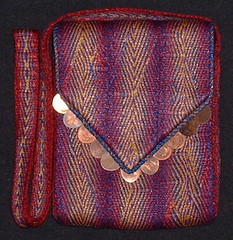
A simple bag, (this happens to be cardwoven bands, but inkle would do as well), done by sewing and folding bands together.
Now that I am on a tear, I'll do a simple tutorial on inkle weaving in a few days. Plus the instructions on how to put this bag together. In the meantime, for inspriation, go see Kathy Wishnie's beautiful inkle band bags.
Regarding conferences, I think a lot of people (ok, maybe just me) think that you have to be an experienced weaver or spinner to participate. Convergence was in my hometown when I was just beginning to weave, and I didn't go because I didn't realize they had stuff for beginners.
got me to thinking this morning.
Oh, would that all conferences had beginning classes. Do knitting conferences? Do fiber festivals, like MD$&W? Weaving conferences sometimes do, sometimes don't. What a missed opportunity when they don't.
SOAR (the annual spinning conference hosted by Interweave) has in the last 5 years or so, been committed to having a beginning spinning class, taught by Maggie Casey. A very good idea, and a grand way to help enable partners and friends. Convergence, when it was held in Denver (2004) had a Learn to Warp class, taught by Judy Steinkoenig. Both of these teachers are from Boulder, CO, and happen to own Shuttles, Spindles and Skeins in the Table Mesa Plaza (for you locals). They teach both beginning spinning and weaving regularly, and very well, by all reports.
Would that every area had such a resource, and if not, that every conference could provide beginning classes. Some conferences seem to try to outdo themselves with obscure classes, new work, new directions, or very advanced subjects only the esoteric few would enjoy.
Beginning weaving, inkle loom classes, Warp Your Loom classes, and cardweaving classes are all tailor made for bringing new and interested people into the fold (heh). But the second part of Ellen's comment was that she didn't know the classes were there.
Publicity. Oft overlooked, and a chore to some, obviously would have paid off here.
I'm sure there is more interest because of the internet: lists, blogs, and websites of vendors all help bring the curious and the knowledgeable together. Guilds are very good at the *one step ahead of you* enabling: the new teachers who are excited about what they have just learned, and want to share it. Some paid teachers are this too: and the enthusiasm of the newly learned process is a benefit.
But conferences could provide a knowledgeable teacher, the vendors and suppliers, as well as a gallery of works to inspire, all in one place, with several dozen other enthusiasts with which to share!
Let's hope the conference organizers take up the banner, and provide beginning classes, not just the esoteric and the fabulous multi-thousand harness aficionado classes (and then *tell* people about it!).
For Naomi, who asked about bands:

A simple bag, (this happens to be cardwoven bands, but inkle would do as well), done by sewing and folding bands together.
Now that I am on a tear, I'll do a simple tutorial on inkle weaving in a few days. Plus the instructions on how to put this bag together. In the meantime, for inspriation, go see Kathy Wishnie's beautiful inkle band bags.
Monday, May 15, 2006
There is Weaving and There is Weaving
Oh. Hmmm. So. Normally this blog gets about 300 hits a day. Last Monday, carrying over to Tuesday, there were over 1200 hits. News gets around, I guess, and the subject matter might have been a bit provoking.
There were also a corresponding number of comments, both on and off blog. Wonderful comments, I might add, and thanks! One of the more thoughtful responses was by Carrie Brezine, whom I first *met* through her article in this book. I am both surprised, and pleased: the response level indicates an interest in weaving, at least, for which I am grateful.
So far, many of us have agreed the guild system is flagging. Some guilds are thriving, some, not so much. Conferences are put on by these organizations, so if guilds become extinct, perhaps so will the conferences that I have so enjoyed. I think conferences can be a good teaching venue, and a way to introduce weaving and spinning to people who do not know we still do these things. The guild system alone is worth exploring: will it recover, is it in need of an overhaul, will something else replace it? Obviously, as far as communication goes, the internet, lists and web logs are accessible and working well. Perhaps this will be all that we need.
I did get quite a reaction, however, with my perhaps cavalier comment that time, space and money are yes, impediments, but not daunting.
Well, it depends. For some people they are daunting. Perhaps I need to clarify: in the weaving I prefer, very little money or space is required. Time? Yes, we need time.
Weaving seems no more expensive to me than other related fiber hobbies: yarn for a sweater can easily run over $100 and that's just one sweater. You have to spend that $100 for every batch of entertainment, um, knitting. Spinning? A spindle can be a thrifty tool, but then there's that fiber: and we all know just a little is not enough. A wheel can easily be over $300. A good sewing machine can cost $600 (or much more), and that's not counting the expensive iron, the cloth and all the presser feet one can find. These prices are comparable to small weaving equipment. Yes, all this stuff can be put away in a closet, but if you *have* the closet space, you have the room for weaving equipment.
Or I would, since my weaving these days is more of the finger manipulated kind, and tactile. I describe it as *more like knitting* since I am doing knot by knot, thread by thread, and getting my fingers involved.
My preferences perhaps contrast with what most people must think of as weaving: big floor loom, complex warping and drafting, fabric which takes lots of time to weave off, requiring focus and study (and sewing skills). I have a floor loom, yes, and all the cones of yarn I could want for a while. They take up space. But for the last several years, I have done most of my weaving on this homely upright loom:

and the side view:

an inkle loom:

not so homely. Purchased, not home made, from Schacht.
And on small cards:
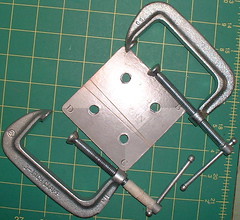 .
.
The upright loom takes about as much space as a side chair. The inkle loom is clamped to a table, but can be easily put away if the table space is needed. The cardweaving, well, what can I say?, it takes the space of a small bag.
These can provide hours, if not a lifetime, of weaving pleasure. There is complexity here enough to satisfy the most mathematical of minds, as well as simple hours of weaving fun.
The most expensive piece of equipment above is the inkle loom, coming in at about $70 these days. The upright loom (no longer made) could be built using about $100 of materials and a few tools.
On this unlovely equipment I have woven this:
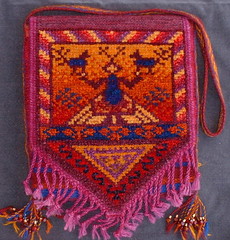
and these:

and these:
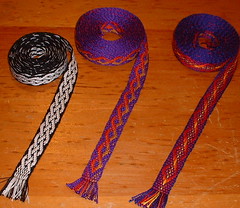
One can learn a lot about weaving on a back strap loom (which I prefer to call a hip strap loom, to indicate where the strap should actually lie), or simple frame looms, including the oft-mentioned-here pipe loom, whether it's PVC, copper or galvanized pipe.
Yes, you can buy $3000 looms that take up the floor space of a small factory (which they are). Yes, you can buy warping reels, yarn winders, swifts, bobbin winders, piles of reeds and enough books to open a small library.
Or not.
Weaving is not limited to fabric. Not everyone weaves for clothing. The weaving I most often do could be classified as beginner weaving. And it is. Very basic, very accessible, and very much weaving. Also, no less interesting, despite its beginner nature, to those who want to be mentally challenged. Cardweaving alone can be lifetime of discovery, challenging minds far greater than mine.
I did not start with a floor loom and a studio full of yarn. I started with a frame loom, then a hand made loom, then worked my way up to a studio full of equipment, worktables, a library and yarn in 30 years (not to mention some sheep, which went by the wayside because of that time issue: I'd rather weave).
I may be out of step in the craft world in general: I do what I do for the pleasure of the activity. Because of that, I find the time. When I was working and raising children, I got up early, like even 4 A.M., in order to find the time to do a little each day (this had the side benefit of not making me anxious to try to get stuff out of the way during the day: I had my *fix* already).
I am knitting lace shawls, which I may never wear and most likely will give away, because of the pleasure of the activity. I find it fun to weave knotted pile, and with it I make bags. I have about 15 so far. Obviously, I don't need more bags. But I weave more. Bands, whether cardwoven or pick-up, are fascinating and fun to weave. I have a box full. Someday they may be useful, but for the most part, it's the process.
I so appreciate this conversation, may it continue. I have had much to think about while I weave this week, thanks! I had planned to post about inspiration, and what inspires me to keep this up, but I have appreciated also more clearly defining what I like to do.
There were also a corresponding number of comments, both on and off blog. Wonderful comments, I might add, and thanks! One of the more thoughtful responses was by Carrie Brezine, whom I first *met* through her article in this book. I am both surprised, and pleased: the response level indicates an interest in weaving, at least, for which I am grateful.
So far, many of us have agreed the guild system is flagging. Some guilds are thriving, some, not so much. Conferences are put on by these organizations, so if guilds become extinct, perhaps so will the conferences that I have so enjoyed. I think conferences can be a good teaching venue, and a way to introduce weaving and spinning to people who do not know we still do these things. The guild system alone is worth exploring: will it recover, is it in need of an overhaul, will something else replace it? Obviously, as far as communication goes, the internet, lists and web logs are accessible and working well. Perhaps this will be all that we need.
I did get quite a reaction, however, with my perhaps cavalier comment that time, space and money are yes, impediments, but not daunting.
Well, it depends. For some people they are daunting. Perhaps I need to clarify: in the weaving I prefer, very little money or space is required. Time? Yes, we need time.
Weaving seems no more expensive to me than other related fiber hobbies: yarn for a sweater can easily run over $100 and that's just one sweater. You have to spend that $100 for every batch of entertainment, um, knitting. Spinning? A spindle can be a thrifty tool, but then there's that fiber: and we all know just a little is not enough. A wheel can easily be over $300. A good sewing machine can cost $600 (or much more), and that's not counting the expensive iron, the cloth and all the presser feet one can find. These prices are comparable to small weaving equipment. Yes, all this stuff can be put away in a closet, but if you *have* the closet space, you have the room for weaving equipment.
Or I would, since my weaving these days is more of the finger manipulated kind, and tactile. I describe it as *more like knitting* since I am doing knot by knot, thread by thread, and getting my fingers involved.
My preferences perhaps contrast with what most people must think of as weaving: big floor loom, complex warping and drafting, fabric which takes lots of time to weave off, requiring focus and study (and sewing skills). I have a floor loom, yes, and all the cones of yarn I could want for a while. They take up space. But for the last several years, I have done most of my weaving on this homely upright loom:

and the side view:

an inkle loom:

not so homely. Purchased, not home made, from Schacht.
And on small cards:
 .
.The upright loom takes about as much space as a side chair. The inkle loom is clamped to a table, but can be easily put away if the table space is needed. The cardweaving, well, what can I say?, it takes the space of a small bag.
These can provide hours, if not a lifetime, of weaving pleasure. There is complexity here enough to satisfy the most mathematical of minds, as well as simple hours of weaving fun.
The most expensive piece of equipment above is the inkle loom, coming in at about $70 these days. The upright loom (no longer made) could be built using about $100 of materials and a few tools.
On this unlovely equipment I have woven this:

and these:

and these:

One can learn a lot about weaving on a back strap loom (which I prefer to call a hip strap loom, to indicate where the strap should actually lie), or simple frame looms, including the oft-mentioned-here pipe loom, whether it's PVC, copper or galvanized pipe.
Yes, you can buy $3000 looms that take up the floor space of a small factory (which they are). Yes, you can buy warping reels, yarn winders, swifts, bobbin winders, piles of reeds and enough books to open a small library.
Or not.
Weaving is not limited to fabric. Not everyone weaves for clothing. The weaving I most often do could be classified as beginner weaving. And it is. Very basic, very accessible, and very much weaving. Also, no less interesting, despite its beginner nature, to those who want to be mentally challenged. Cardweaving alone can be lifetime of discovery, challenging minds far greater than mine.
I did not start with a floor loom and a studio full of yarn. I started with a frame loom, then a hand made loom, then worked my way up to a studio full of equipment, worktables, a library and yarn in 30 years (not to mention some sheep, which went by the wayside because of that time issue: I'd rather weave).
I may be out of step in the craft world in general: I do what I do for the pleasure of the activity. Because of that, I find the time. When I was working and raising children, I got up early, like even 4 A.M., in order to find the time to do a little each day (this had the side benefit of not making me anxious to try to get stuff out of the way during the day: I had my *fix* already).
I am knitting lace shawls, which I may never wear and most likely will give away, because of the pleasure of the activity. I find it fun to weave knotted pile, and with it I make bags. I have about 15 so far. Obviously, I don't need more bags. But I weave more. Bands, whether cardwoven or pick-up, are fascinating and fun to weave. I have a box full. Someday they may be useful, but for the most part, it's the process.
I so appreciate this conversation, may it continue. I have had much to think about while I weave this week, thanks! I had planned to post about inspiration, and what inspires me to keep this up, but I have appreciated also more clearly defining what I like to do.
Friday, May 12, 2006
Still Working
Amidst all this ruminating, weaving is still going on:

The silk wedding fabric is done. This is 3 yards for a shawl, and another 5 yards for two vests. Half of the five yard piece needs to be dyed black, then I am taking them to be steam pressed. I have a mangle, one of those old '50's home ironing jobs, but it is buried in storage. The local laundry will be pressed (heh) into service instead of digging out the mangle, setting it up and finding a long extension cord.
The detail shot:
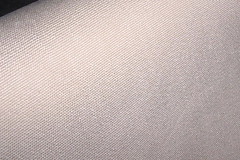
Hard to capture, but there is a bit of variation to the plain weave. This is 30's/2 spun silk sett at 48, with 20's/2 silk sett random in the warp. The 20's/2 gives a lovely variation in the surface shine, just enough to know *something* is going on, it's not just plain fabric (but maybe this effect is only in my imagination, because who wants to go through the trouble, if it doesn't show?).
A sexy slinky shot:
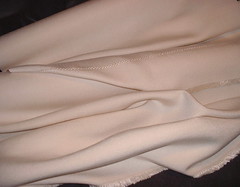
And the ends:
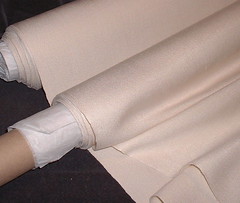
to give you an idea of just how much fabric I ironed yesterday!
All white, all the time. Perhaps not so inspiring, after all this talk the last few posts, just real, beautiful fabric. That I made myself. For people I love.

The silk wedding fabric is done. This is 3 yards for a shawl, and another 5 yards for two vests. Half of the five yard piece needs to be dyed black, then I am taking them to be steam pressed. I have a mangle, one of those old '50's home ironing jobs, but it is buried in storage. The local laundry will be pressed (heh) into service instead of digging out the mangle, setting it up and finding a long extension cord.
The detail shot:

Hard to capture, but there is a bit of variation to the plain weave. This is 30's/2 spun silk sett at 48, with 20's/2 silk sett random in the warp. The 20's/2 gives a lovely variation in the surface shine, just enough to know *something* is going on, it's not just plain fabric (but maybe this effect is only in my imagination, because who wants to go through the trouble, if it doesn't show?).
A sexy slinky shot:

And the ends:

to give you an idea of just how much fabric I ironed yesterday!
All white, all the time. Perhaps not so inspiring, after all this talk the last few posts, just real, beautiful fabric. That I made myself. For people I love.
Wednesday, May 10, 2006
Further Thoughts
Time, space and money are often cited as impediments to weaving at home, and they can be. But we know that when one is passionate, impediments like these can be overcome.
Several comments, both on and off blog, have pointed to the issue of inspiration: how to and how not to inspire new weavers. Therein lies the rub.
New knitters, as we all know, came on board in droves because of Fun Fur yarns: bright colors, simple projects, flashy textures.
Weaving can be all that, but it is not currently. Weaving is perceived as tricky, ponderous, unattainable except by long and arduous study. Some weavers perpetuate this perception, and some weaving, by its computer-driven complex nature, *is* tricky, ponderous and time consuming.
I learned to weave in the mid-70's in San Francisco, at the Fort Mason Art Center during the Big Yarn phase of post-hippiedom. I managed to survive the Big Yarn, and eventually get down to Real Weaving (tm).
Instruction was by Kay Sekimachi, who, even then was a well known weaver. Kay had been taught at CCAC by Trude Guermonprez, one of the Bauhaus weavers blown to the US by the winds ahead of Hitler's Army.
Kay, even then, wove delicate linen and monofilament pieces, many layered and complex in their folding and completion.
We wove with hog guts.
She must have been cringing. We would never have known. She was gracious and calm, she taught and answered our questions, never critiqued our work, unless we asked.
The result? Lots of weavers sailed through an exciting learning phase, and took some time to settle down to weaving real fabric.
Will the Fun Fur knitters do the same? Yes, a certain percentage of them will come to real wool, real fibers, and real knitting.
So do we need a Fun Fur Weaving phase to revitalize the craft?? Maybe weaving with wild metallics, ribbons, bright colors, all mish mash, a Dorothy Liebes for the new century?
Archie Brennan has gone a long way to bringing weaving into the hands of beginners with his simple copper pipe loom design, given out freely. It allows anyone with $20 to make their own loom, and weaving fun fur scarves on a long version of the loom is infinitely possible: see Sarah Swett's book Kids Weaving.
So simple, inexpensive equipment is out there, Big Yarns are also out there. Somehow, we need to put the two together into inspiring projects for new weavers.
Any volunteers??
Luckily, I did a warp painting demo this past weekend at CNCH:
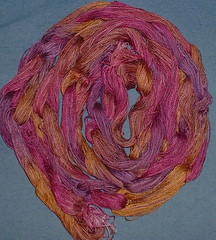
Otherwise, this post would be devoid of pictures. Horrors.
Several comments, both on and off blog, have pointed to the issue of inspiration: how to and how not to inspire new weavers. Therein lies the rub.
New knitters, as we all know, came on board in droves because of Fun Fur yarns: bright colors, simple projects, flashy textures.
Weaving can be all that, but it is not currently. Weaving is perceived as tricky, ponderous, unattainable except by long and arduous study. Some weavers perpetuate this perception, and some weaving, by its computer-driven complex nature, *is* tricky, ponderous and time consuming.
I learned to weave in the mid-70's in San Francisco, at the Fort Mason Art Center during the Big Yarn phase of post-hippiedom. I managed to survive the Big Yarn, and eventually get down to Real Weaving (tm).
Instruction was by Kay Sekimachi, who, even then was a well known weaver. Kay had been taught at CCAC by Trude Guermonprez, one of the Bauhaus weavers blown to the US by the winds ahead of Hitler's Army.
Kay, even then, wove delicate linen and monofilament pieces, many layered and complex in their folding and completion.
We wove with hog guts.
She must have been cringing. We would never have known. She was gracious and calm, she taught and answered our questions, never critiqued our work, unless we asked.
The result? Lots of weavers sailed through an exciting learning phase, and took some time to settle down to weaving real fabric.
Will the Fun Fur knitters do the same? Yes, a certain percentage of them will come to real wool, real fibers, and real knitting.
So do we need a Fun Fur Weaving phase to revitalize the craft?? Maybe weaving with wild metallics, ribbons, bright colors, all mish mash, a Dorothy Liebes for the new century?
Archie Brennan has gone a long way to bringing weaving into the hands of beginners with his simple copper pipe loom design, given out freely. It allows anyone with $20 to make their own loom, and weaving fun fur scarves on a long version of the loom is infinitely possible: see Sarah Swett's book Kids Weaving.
So simple, inexpensive equipment is out there, Big Yarns are also out there. Somehow, we need to put the two together into inspiring projects for new weavers.
Any volunteers??
Luckily, I did a warp painting demo this past weekend at CNCH:

Otherwise, this post would be devoid of pictures. Horrors.
Monday, May 08, 2006
The Future of Weaving
Grandiose title, eh? Consider this the opening volley in a potentially long conversation.
This past weekend was the annual Conference of Northern California Handweavers. There were seminars, lectures, vendors, a gallery of work, demonstrations and a fashion show. Attendance seemed adequate, not great, but classes were full. Vendors? I don't think they had enough customers. The usual walk-in traffic was very light.
There was time to have several conversations with fellow conference attendees, and the subject, as it has been for the past several years, has been: where are we headed?
From inklings a few years ago that we, as a group, are aging, that younger people are not joining us, to the certainty now that, as we become less able, and wish to sell off books, equipment, and yarns, there are few people interested in taking up the craft we have so earnestly pursued.
Local weaving guilds used to be the lifeblood of weaving instruction. Guilds have declined in numbers, and have a aging population, but most people can point to the main reason why: they usually meet mid-day, midweek. Working adults cannot attend regularly.
Some guilds do meet evenings, or weekends, and often their rosters reflect healthy numbers. But participation is definitely down, in guild activities, workshops, conferences, and shows.
What is the true weaving level, versus the simple numbers of members? What percentage of guild members actually weave, enter guild shows and conferences, and attend workshops? I have heard the estimate that 20% of weavers who subscribe to Handwoven actually weave. The rest are former weavers, loyal and still interested, or potential weavers, interested but not yet weaving.
Conferences around this country are the work of guilds, guild members and their volunteers. Fewer and fewer volunteers can be found, and more work is required of the few who do step up, making them less likely to want to repeat the grueling two to three year commitment required to stage a major show. Are conferences going the way of the Dodo?
There are classes at University level, certainly, but not nearly as many programs as were in existence when I started weaving. University trained weavers rarely join the guilds: there is a disconnect, whether intentional or not. One friend, who has a degree from RISD in weaving, says there is active denigration of the guild system in the school programs: *only little old ladies join the guilds, and their weaving is traditional and uninspired*. Hmm. How small minded, and how wrong. Lots of wonderful, creative work is done in quiet corners, by weavers who learned in guild workshops, and went home to self-study and effort.
One of my favorite conversations this weekend was with Vicky Fraser, of the California Rug Project. Native Californian Vicky has spent the last 12 years involved in spinning, dyeing and weaving this rug. The loom was custom built for her by her son, she has spun the 9 ply cotton warp, the wool weft, dyed the wool with natural dyes, taught several people to weave with her, and woven about two thirds of the way up the state. It is a lively and fascinating project, and a very beautiful rug: a legacy of the diversity of the state and a labor of love.
There were several pieces in the gallery that were breathtaking: I especially liked Marlene Golden's silk scarf. I had no camera (perhaps a good thing) but I will try to get a photo from Marlene.
I have no grand insights or real answers to the State of the Art. I don't know what is next, I don't know how to attract new people, and I don't know if the whole guild/conference thing needs to die a natural death. In the end, it is what it is, and will be what will be (how zen).
Any insights, comments, suggestions? If you don't wish to comment here, email me. I plan to rant and rave for a few more posts about teaching, learning and the value of time to create, among others (I know, run screaming now, it sounds exciting to me too).
I came home late last evening, and woke up to a very green yard:
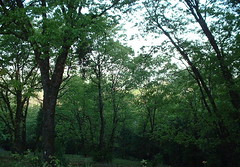
It is amazing how quickly things change when one is gone. It is hard to capture the green glow everything has taken on: Spring has certainly sprung: the air is green, the light is green, the canopy has filled out and makes everything green. I have been gardening:
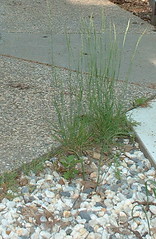
Or perhaps I should get to the gardening??
Mojo has taken the time to fling himself up trees:
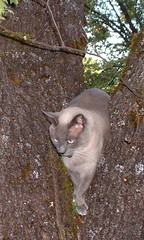
And me? I'll retire to the yurt, the better to contemplate the state of the art, so to speak:
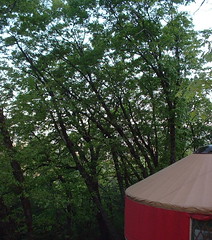
This past weekend was the annual Conference of Northern California Handweavers. There were seminars, lectures, vendors, a gallery of work, demonstrations and a fashion show. Attendance seemed adequate, not great, but classes were full. Vendors? I don't think they had enough customers. The usual walk-in traffic was very light.
There was time to have several conversations with fellow conference attendees, and the subject, as it has been for the past several years, has been: where are we headed?
From inklings a few years ago that we, as a group, are aging, that younger people are not joining us, to the certainty now that, as we become less able, and wish to sell off books, equipment, and yarns, there are few people interested in taking up the craft we have so earnestly pursued.
Local weaving guilds used to be the lifeblood of weaving instruction. Guilds have declined in numbers, and have a aging population, but most people can point to the main reason why: they usually meet mid-day, midweek. Working adults cannot attend regularly.
Some guilds do meet evenings, or weekends, and often their rosters reflect healthy numbers. But participation is definitely down, in guild activities, workshops, conferences, and shows.
What is the true weaving level, versus the simple numbers of members? What percentage of guild members actually weave, enter guild shows and conferences, and attend workshops? I have heard the estimate that 20% of weavers who subscribe to Handwoven actually weave. The rest are former weavers, loyal and still interested, or potential weavers, interested but not yet weaving.
Conferences around this country are the work of guilds, guild members and their volunteers. Fewer and fewer volunteers can be found, and more work is required of the few who do step up, making them less likely to want to repeat the grueling two to three year commitment required to stage a major show. Are conferences going the way of the Dodo?
There are classes at University level, certainly, but not nearly as many programs as were in existence when I started weaving. University trained weavers rarely join the guilds: there is a disconnect, whether intentional or not. One friend, who has a degree from RISD in weaving, says there is active denigration of the guild system in the school programs: *only little old ladies join the guilds, and their weaving is traditional and uninspired*. Hmm. How small minded, and how wrong. Lots of wonderful, creative work is done in quiet corners, by weavers who learned in guild workshops, and went home to self-study and effort.
One of my favorite conversations this weekend was with Vicky Fraser, of the California Rug Project. Native Californian Vicky has spent the last 12 years involved in spinning, dyeing and weaving this rug. The loom was custom built for her by her son, she has spun the 9 ply cotton warp, the wool weft, dyed the wool with natural dyes, taught several people to weave with her, and woven about two thirds of the way up the state. It is a lively and fascinating project, and a very beautiful rug: a legacy of the diversity of the state and a labor of love.
There were several pieces in the gallery that were breathtaking: I especially liked Marlene Golden's silk scarf. I had no camera (perhaps a good thing) but I will try to get a photo from Marlene.
I have no grand insights or real answers to the State of the Art. I don't know what is next, I don't know how to attract new people, and I don't know if the whole guild/conference thing needs to die a natural death. In the end, it is what it is, and will be what will be (how zen).
Any insights, comments, suggestions? If you don't wish to comment here, email me. I plan to rant and rave for a few more posts about teaching, learning and the value of time to create, among others (I know, run screaming now, it sounds exciting to me too).
I came home late last evening, and woke up to a very green yard:

It is amazing how quickly things change when one is gone. It is hard to capture the green glow everything has taken on: Spring has certainly sprung: the air is green, the light is green, the canopy has filled out and makes everything green. I have been gardening:

Or perhaps I should get to the gardening??
Mojo has taken the time to fling himself up trees:

And me? I'll retire to the yurt, the better to contemplate the state of the art, so to speak:

Tuesday, May 02, 2006
Much Ado
Well! First, thank you for all the comments, both enblogue, so to speak, and off. I am surprised at the response, a chord must have been struck.
I've been thinking of the follow-up post, passing on the passion, but I haven't the time right now, having gotten myself over-busy. Next week. I expect by then to be over the hump, and back to a more sedate pace, and able to concentrate rather than rush from task to task, as I feel I am doing this week.
Sometimes we are our own worst enemy.
In the meantime, the shawl:
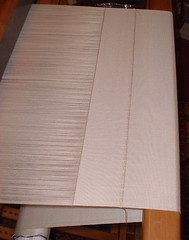
This is the hemstitched end, here's a close up:
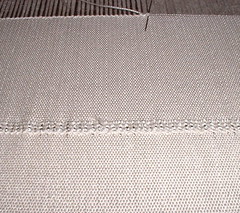
There are four threads through each slot in the reed (48 epi in a 12 dent reed), so theoretically I could have four threads in each turn of the needle. But nooooo, that would be too easy. Me? I just pick up random threads, sometimes four, sometimes five, sometimes three, and stitch across. This is what passes for wild and rebellious in the weaving world.
The stitching is intended to mark the end of the shawl, then there is a hem area, which will be turned and hemstitched back on itself, making two lines of hemstitching followed by an inch of turned over hem. This hem area will be beaded, very simply, with pearls and silver lined beads. The beading will give the ends some body and weight, the better for draping, and staying in place. Like drapery weights, for those of you who remember the pinch pleated drapes of the past.
All this white silk weaving continues, for several more yards: for the groom's vest and that of his best man. Snowblind? Why, yes! thanks for asking.
As a respite from all this plain white, I have been internet surfing. I like to go look at Linda's site, and admire all her dyed wool color combinations. I succumbed:
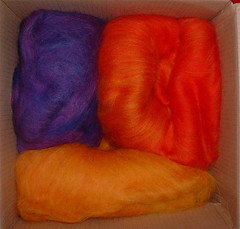
Like those colors Marcy? And while I was there, I ordered a Big Honking crochet hook:
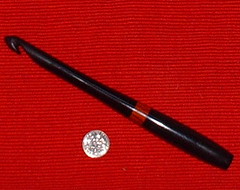
To be used for an eventual crocheted and felted bag.
But not yet, I am undeterred. The nose must be pressed to the grindstone for a bit more. Thank you again for all your thoughtful and encouraging comments. We must be a very passionate bunch.
I've been thinking of the follow-up post, passing on the passion, but I haven't the time right now, having gotten myself over-busy. Next week. I expect by then to be over the hump, and back to a more sedate pace, and able to concentrate rather than rush from task to task, as I feel I am doing this week.
Sometimes we are our own worst enemy.
In the meantime, the shawl:

This is the hemstitched end, here's a close up:

There are four threads through each slot in the reed (48 epi in a 12 dent reed), so theoretically I could have four threads in each turn of the needle. But nooooo, that would be too easy. Me? I just pick up random threads, sometimes four, sometimes five, sometimes three, and stitch across. This is what passes for wild and rebellious in the weaving world.
The stitching is intended to mark the end of the shawl, then there is a hem area, which will be turned and hemstitched back on itself, making two lines of hemstitching followed by an inch of turned over hem. This hem area will be beaded, very simply, with pearls and silver lined beads. The beading will give the ends some body and weight, the better for draping, and staying in place. Like drapery weights, for those of you who remember the pinch pleated drapes of the past.
All this white silk weaving continues, for several more yards: for the groom's vest and that of his best man. Snowblind? Why, yes! thanks for asking.
As a respite from all this plain white, I have been internet surfing. I like to go look at Linda's site, and admire all her dyed wool color combinations. I succumbed:

Like those colors Marcy? And while I was there, I ordered a Big Honking crochet hook:

To be used for an eventual crocheted and felted bag.
But not yet, I am undeterred. The nose must be pressed to the grindstone for a bit more. Thank you again for all your thoughtful and encouraging comments. We must be a very passionate bunch.
